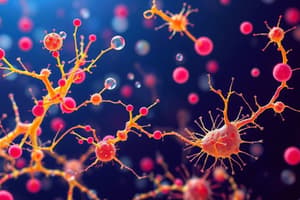Podcast
Questions and Answers
What are prokaryotes?
What are prokaryotes?
Simple cells without a nucleus.
Give an example of a bacterium and its characteristic.
Give an example of a bacterium and its characteristic.
E. coli - have a cell wall.
What is a eukaryote?
What is a eukaryote?
Complex cells with a nucleus.
What is a viroid?
What is a viroid?
Define a prion.
Define a prion.
How did ancient Egyptians use molds?
How did ancient Egyptians use molds?
Match the following microbiologists with their contributions:
Match the following microbiologists with their contributions:
What is Koch's first postulate?
What is Koch's first postulate?
Name one limitation of Koch's postulates.
Name one limitation of Koch's postulates.
What is the difference between signs and symptoms?
What is the difference between signs and symptoms?
What are normal microbiota?
What are normal microbiota?
What can normal microbiota do to prevent overgrowth of pathogens?
What can normal microbiota do to prevent overgrowth of pathogens?
How is the microbiome acquired?
How is the microbiome acquired?
Define acute infection.
Define acute infection.
What is a chronic infection?
What is a chronic infection?
What is an opportunistic infection?
What is an opportunistic infection?
Study Notes
Differences Between Microorganisms
- Prokaryotes: Simple cells lacking a nucleus.
- Bacteria: Example - E. coli, characterized by a cell wall.
- Archaea: Example - Methanogens, thrive in extreme environments with unique membranes.
- Eukaryotes: Complex cells with a nucleus.
- Protists: Example - Paramecium, single-celled with organelles.
- Fungi: Example - Yeast, featuring a cell wall made of chitin.
- Viruses: Consist of genetic material encased in a protein coat; not classified as living.
- Example: Influenza virus.
- Viroids: Composed of short RNA strands affecting plants.
- Example: Potato spindle tuber viroid.
- Prions: Abnormal proteins causing neurodegenerative diseases.
- Example: Creutzfeldt-Jakob disease.
- Protozoa: Animal-like protists; be cautious about drinking water.
Ancient Use of Microbiology
- Ancient Egyptians utilized molds in the brewing of beer and bread making, leveraging yeast.
Contributions to Microbiology
- Florence Nightingale: Pioneered the understanding of how germs contribute to disease; documented soldiers' deaths.
- Louis Pasteur: Renowned as the father of microbiology; disproved spontaneous generation.
- Ignaz Semmelweis: Advocated for handwashing among doctors to reduce infections during childbirth; faced resistance.
- Joseph Lister: Innovated disinfection techniques for surgical instruments.
- Edward Jenner: Developed the first smallpox vaccine.
- Robert Koch: Identified pathogens, establishing methods for isolating microorganisms, especially for cholera.
- Alexander Fleming: Discovered penicillin, the first true antibiotic.
Koch’s Postulates
- Postulate 1: Isolate the pathogen from an infected host.
- Postulate 2: Grow the pathogen in pure culture.
- Postulate 3: Introduce the cultured pathogen into a healthy host and observe results.
- Postulate 4: Re-isolate the pathogen from the newly infected host.
Limitations of Koch's Postulates
- Some microbes, like viruses, cannot be cultured outside a host.
- Lack of suitable animal models for certain pathogens; for example, syphilis cannot infect many animal species.
- Non-pathogenic strains can be present; many HIV carriers show no symptoms.
- Asymptomatic carriers may harbor pathogens without showing signs of illness.
- Chronic carriers may continuously infect others without exhibiting symptoms.
Signs vs. Symptoms
- Signs: Observable indicators of disease (e.g., rash).
- Symptoms: Subjective experiences reported by the patient (e.g., headache).
Normal Microbiota vs. Pathogens
- Normal Microbiota: Beneficial microorganisms residing in the body (e.g., Lactobacillus).
- Pathogens: Harmful microorganisms that lead to disease (e.g., Staphylococcus aureus).
Microbial Antagonism
- Compete for nutrients to outcompete pathogenic bacteria.
- Produce antimicrobial substances that inhibit or destroy pathogens.
- Maintain pH levels by generating acids which deter pathogen growth.
Acquisition and Factors Influencing Microbiome
- Acquired through mechanisms such as birth, environmental exposure, and dietary habits.
- Factors influencing microbiome composition:
- Birth Method: Differences in microbiota of vaginal vs. cesarean deliveries.
- Diet: Dietary changes can significantly alter the microbiome's makeup.
- Antibiotics: Use can disrupt and diminish normal microbiota.
Types of Infections
- Acute: Rapid onset and short duration (e.g., flu).
- Chronic: Prolonged infection (e.g., tuberculosis).
- Opportunistic: Infections arising in immunocompromised individuals (e.g., Candida).
- Secondary: Subsequent infection following a primary one (e.g., bacterial pneumonia post-flu).
- Localized: Confined to a specific body area (e.g., boil).
- Focal: An infection that spreads from a local site to cause illness elsewhere.
- Systemic: Widespread infection affecting various body parts.
- Latent: Infections that are dormant and may reactivate (e.g., herpes simplex).
Studying That Suits You
Use AI to generate personalized quizzes and flashcards to suit your learning preferences.
Description
Prepare for your Biology Exam I with this comprehensive study guide focused on Chapter 1. Learn about the characteristics of prokaryotes, eukaryotes, viruses, viroids, and prions, along with specific examples for each. This guide covers essential differences and traits necessary for your success in the exam.




